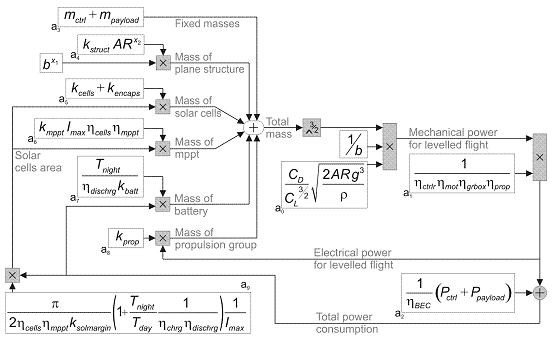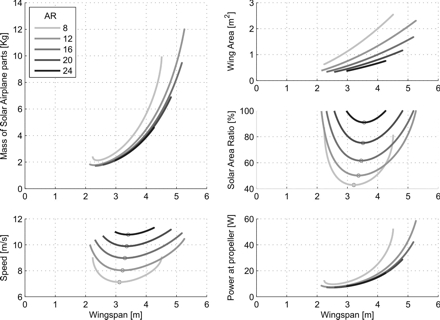Sky-Sailor is a complex system where the design of each component is depending on the design of the others. The energy and mass balances are the starting point of the global design. In fact, the energy collected during the day by the solar panels has
to be sufficient to power the motor, the onboard electronics and also charge the battery that provides enough power to fly from dusk to the next morning when a new cycle starts. Likewise, the lift force has to balance exactly the airplane weight so that the altitude is maintained.
This leads finally to an hen and egg problem: the required power consumption allows dimensioning the various parts, like motor, solar cells, battery, etc. but at the same time these parts determine the airplane gross weight used for the calculation of the required power. One method to solve this problem is to achieve several design iterations, but the method we chose was to express all these relations with equations. That leads to the following graph:

Having the different mathematical models, it is then simple to find potential solutions, evaluate them and investigate the layout of the airplane (wingspan, chord, mass). Of course, this concerns only the conceptual design and needs good mathematical models, relating for example the energy of a motor and its weight. Then comes the preliminary design phase where we enter more into details for the design of all the parts. The complete Conceptual Design Methodology can be found in this pdf document:
Conceptual Design of Solar Powered Airplanes for continuous flight.pdf
The key constraints on the airplane design in terms of weight and dimensions are the required capacity to embed 0.5 [kg] scientific payload and the ability to be stowed in a cylinder of 1 [m] diameter and 0.4 [m] height. According to those requirements, Sky-Sailor version 1 was designed. It has a wingspan of 3.2 [m] and a total weight of around 2.5 [kg]. The wing has winglets to its extremities, in order to prevent vortex around wing tip, which decreases lift at the tip, and a V-Tail ends the fuselage. Based on aerodynamics studies, the power required for a low altitude flight on Earth is around 13.2 [W].
